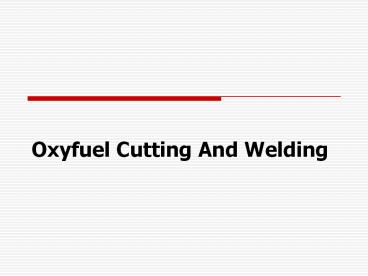Oxyfuel Cutting And Welding - PowerPoint PPT Presentation
Title: Oxyfuel Cutting And Welding
1
Oxyfuel Cutting And Welding
2
Introduction
3
- Oxyfuel the process of combining pure oxygen
with a combustible fuel gas to produce a flame - Can be used for welding, brazing, cutting, and
heating metals - Oxygen fuel gases are stored under pressure in
cylinders and are released as individual gases
through valves, regulators, and hoses. - Mixed as they flow through torch assemblies
- Burn as they are discharged through special tips
4
- Fuel gases
- Propane, natural gas, propylene acetylene
- Vary in their chemical composition
- React with the metal in different ways
- Factors to consider in selecting a gas
- Availability cost
- Welding process or operation to be performed
- Thickness of metal type of welded joint to be
produced - Physical properties of metals
- Chemical properties of metals
5
Propane (C3H)
6
- Supplied in a liquid form under positive
pressure, which varies with temperature - Most oxyfuel cutting torches can use LP gas, but
special hoses and cutting tips are required. - Readily available in most areas
- Due to cost, propane cutting is heavily used in
the metal recycling industry.
7
Propylene (C3H6)
8
- Has been used for approximately 30 years
- Stable in both liquid and gas states
- Economical
- Produces little slag
- Has a high heat value
- Does not have the withdrawal pressure limitations
that are necessary with acetylene - Approximately 5 propylene, 87 propane traces
of other gases
9
Acetylene (C2H2)
10
- Most widely used fuel gas for welding and cutting
applications - Produces a clean weld and a controllable flame
- Less stable and more expensive than other fuel
gases - Performs most functions well and is widely
available
11
Compressed Natural Gas (CH4)
12
- Adaptable for cutting, soldering, brazing, and
preheating - A water seal or blowback valve to prevent
backfiring into the gas supply line must protect
the natural gas source.
13
Facts About Oxygen (O2)
14
- Odorless, colorless, tasteless heavier than air
- Makes up about 20 of the atmosphere
- Will not burn by itself
- Produced commercially by causing air to liquefy
- Compressed into steel cylinders at 1,800 to 2,400
pounds per in2 (psi) - Supports combustion and is explosive if handled
improperly - Cylinder sizes 80 to 244 ft3
15
Facts About Acetylene (C2H2)
16
- Colorless, but has a very distinct odor
- Highly combustible
- Cylinder sizes 60 to 300 ft3
- Cylinder contains a porous substance saturated
with liquid acetone - Acetylene is pumped into the cylinder, displacing
some of the acetone - Not under extremely high pressure
- Full cylinder is pressurized to approximately 250
psi - May not be withdrawn at a rate higher than 15 psi
17
Functions of Oxyfuel Heat
18
- Oxyfuel cutting of mild carbon steel heats the
metal to rekindling temperature (1,400oF to
1,800oF), then oxidizes and blows the slag from
the cut with a stream of pure oxygen. - Oxyfuel welding fuses two pieces of metal by
heating them to the melting point with a
combustible mixture of oxygen and fuel gas. - Can be done with or without the use of a welding
rod - Brazing the joining of metals by adding bronze
filler - Soft and hard solders (lead silver alloys) are
the filler materials used in soldering. - The oxyfuel flame is also used to bend, shape,
preheat, stress relieve, post-heat temper metal.































